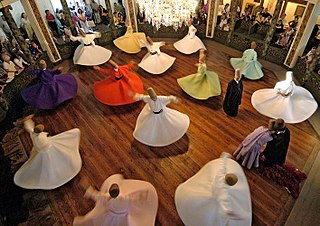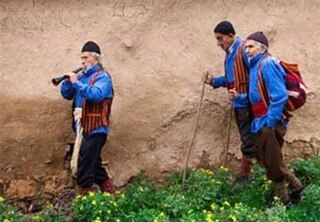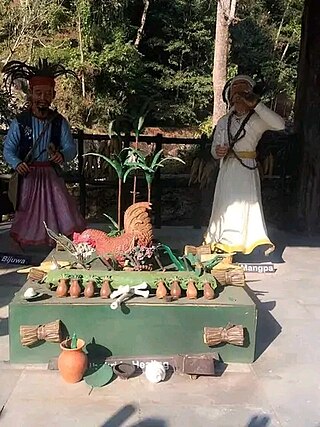This article needs additional citations for verification .(January 2023) |
Mazanderani dances, also known as Tabarian dances, are dances that are performed throughout the world by Mazandarani people, mostly on occasions such as weddings.
This article needs additional citations for verification .(January 2023) |
Mazanderani dances, also known as Tabarian dances, are dances that are performed throughout the world by Mazandarani people, mostly on occasions such as weddings.

Mazandaran province is one of the 31 provinces of Iran, located along the southern coast of the Caspian Sea and in the adjacent Central Alborz mountain range, in central-northern part of the country. The province, founded in 1937, covers an area of 23,842 km2.

Sama is a Sufi ceremony performed as part of the meditation and prayer practice dhikr. Sama means "listening", while dhikr means "remembrance". These performances often include singing, playing instruments, dancing, recitation of poetry and prayers, wearing symbolic attire, and other rituals. Sama is a particularly popular form of worship in Sufism.

Ceremonial dance is a major category or classification of dance forms or dance styles, where the purpose is ceremonial or ritualistic. It is related to and overlaps with sacred dance and ecstatic dance.

Golestan province is one of the 31 provinces of Iran, located in the northeast of the country and southeast of the Caspian Sea. Its capital is Gorgan, formerly called Esterabad until 1937. Golestan was split off from Mazandaran province in 1997.

Sufi whirling is a form of physically active meditation which originated among certain Sufi groups, and which is still practiced by the Sufi Dervishes of the Mevlevi order and other orders such as the Rifa'i-Marufi. It is a customary meditation practice performed within the sema, or worship ceremony, through which dervishes aim to reach greater connection with Allah. This is sought through abandoning one's nafs, ego or personal desires, by listening to the music, focusing on God, and spinning one's body in repetitive circles, which has been seen as a symbolic imitation of planets in the Solar System orbiting the Sun.
Gilaks are an Iranian ethnic group native to the south of Caspian sea. They form one of the main ethnic groups residing in the northern parts of Iran. Gilak people, along with the closely related Mazandarani people, comprise part of the Caspian people, who inhabit the southern and southwestern coastal regions of the Caspian Sea.

Specialty Equipment Market Association (SEMA) of the automobile aftermarket was formed in 1963 by Paul Schiefer, Roy Richter, Ed Iskenderian, Els Lohn, Willie Garner, Bob Hedman, Robert E. Wyman, John Bartlett, Phil Weiand Jr, Al Segal, Dean Moon, and Vic Edelbrock Jr. and now consists of 6,383 companies worldwide, bringing together aftermarket manufacturers, original equipment manufacturers (OEM), media, car dealers, specialty equipment distributors, installers, retailers, and restoration specialists.

Upasampadā (Pali) literally denotes "approaching or nearing the ascetic tradition." In more common parlance it specifically refers to the rite and ritual of ascetic vetting (ordination) by which a candidate, if deemed acceptable, enters the community as upasampadān (ordained) and is authorised to undertake ascetic life.

Mazandarani is an Iranian language of the Northwestern branch spoken by the Mazandarani people. As of 2021, there were 2.38 million native speakers. As a member of the Northwestern branch, etymologically speaking, it is rather closely related to Gilaki and also related to Persian, which belongs to the Southwestern branch. Though the Persian language has influenced Mazandarani to a great extent, Mazandarani still survives as an independent language with a northwestern Iranian origin.

Gilaki is an Iranian language of the Northwestern branch, spoken in south of Caspian Sea by Gilak people. Gilaki is closely related to Mazandarani. The two languages of Gilaki and Mazandarani have similar vocabularies. The Gilaki and Mazandarani languages share certain typological features with Caucasian languages, reflecting the history, ethnic identity, and close relatedness to the Caucasus region and Caucasian peoples of the Gilak people and Mazandarani people.
Dances in Iran or Iranian dances are dance styles indigenous to Iran. Genres of dance in Iran vary depending on the area, culture, and language of the local people, and can range from sophisticated reconstructions of refined court dances to energetic folk dances. The population of Iran includes many ethnicities, such as Kurds, Azerbaijanis, Arabs, Baluchis, Turkmen, Jews, Armenian, Georgian peoples, in addition to numerous Iranian tribal groups which can be found within the borders of modern-day Iran. Each group, region, and historical epoch has specific dance styles associated with it. Raghs is the Arabic word for dance, and is almost exclusively the word used for dance in Persian, as the Persian word for dance, paykubi, is no longer in common usage. It is also the word in Azerbaijani for dance (Reqs). The Kurdish word for dance is Halperke, and the Lurs from Lorestan use the word Bākhten for dance.
Mazanderani, Mazandarani, or Tabarian may refer to:

Ecstatic dance is a form of dance in which the dancers, sometimes without the need to follow specific steps, release themselves to the rhythm and move freely as the music takes them, leading to trance and a feeling of ecstasy. The effects of ecstatic dance begin with ecstasy itself, which may be experienced in differing degrees. Dancers are described as feeling connected to others, and to their own emotions. The dance serves as a form of meditation, helping people to cope with stress and to attain serenity.

The Tabarian New Year, or Neowrez, occurs in the pintek days of the Tabarian Calendar.

Kirat Mundum, also known as Kiratism, or Kirati Mundum, is an animistic folk religion of the Kirati ethnic groups of Nepal, Darjeeling and Sikkim, majorly practiced by Yakkha, Limbu, Sunuwar, Rai, Thami, Jirel, Hayu and Surel peoples in the north-eastern Indian subcontinent. The practice is also known as Kirat Veda, Kirat-Ko Veda or Kirat Ko Ved. According to some scholars, such as Tom Woodhatch, it is a blend of shamanism, animism, and Shaivism. It is practiced by about 3.17% of the Nepali population as of 2021.
Buddhābhiseka refers to a broad range of Buddhist rituals used to consecrate images of the Buddha and other Buddhist figures, such as bodhisattvas.

Amirkola is a city in the Central District of Babol County, Mazandaran province, Iran.

The Sümis are a major Naga ethnic group inhabiting the territories of Zünheboto District, parts of Niuland District and Kiphire District in the Northeast Indian state of Nagaland.
Sümi, also Sema, is a Sino-Tibetan language spoken in Nagaland, India. It is spoken by the Sümi Naga people. It differs from every other Naga languages due to the presence of guttural sounds.

The ordination hall is a Buddhist building specifically consecrated and designated for the performance of the Buddhist ordination ritual (upasampadā) and other ritual ceremonies, such as the recitation of the Pāṭimokkha. The ordination hall is located within a boundary that defines "the space within which all members of a single local community have to assemble as a complete Sangha at a place appointed for ecclesiastical acts ." The constitution of the sīmā is regulated and defined by the Vinaya and its commentaries and sub-commentaries.